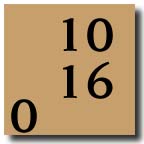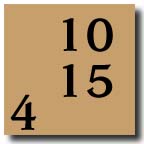Lesson 14 – The Advanced Course – Part 2
Last Updated: February 18, 2020Basic Strategy Variations: Hit or Stand?
The most common decision any player makes at Blackjack is whether to hit or stand, consequently this will be the most common basic strategy variation and you should learn all the important ones. The first is with a hand of 16 against a dealer’s up card of 10. You should stand if the count is 0 or higher and hit if it is less than 0. This means that if the running count is 0 or higher, stand. Since the ‘decision’ number is 0, it’s not necessary to calculate the true count — the running count will do in this situation. Don’t get confused here. Almost all basic strategy variations rely on the true count, but for those where the decision number is 0, the running count will suffice.
The next most important hand is 15 against a dealer’s 10. The decision number is a true count of 4, if you are playing at a game of four decks or more. This variation and the others can be easily learned if you make a set of flashcards. They needn’t be fancy or sophisticated; merely accurate. Cut some 2′” squares from manila folders and they’ll work just fine. A typical flashcard should look like this

If you imagine the 10 and 16 placed on the centerline of a 2″ X 2″ square, the 0 is offset so your left thumb covers the number. As you go through the stack, recite “sixteen versus 10, stand at zero” (or higher). For a hand of 15 vs. 10, a card will look like this

When you come to this card, you’ll recite “15 versus 10; stand at 4”.
As time goes on, you won’t need to remind yourself that you should stand with the 15 against 10, so you’ll recite “15 versus 10 is 4”.
Got the idea?
Here are the numbers you’ll need to learn. These may vary a bit from numbers you’ll see published in books like Stanford Wong’s “Professional Blackjack” because the ones I use are specifically for a six-deck game where the dealer stands on A-6 and a few have been modified based upon the theory of ‘risk averse’ play which was developed about 15 years ago. These numbers work well; they have been proven in thousands of hours of actual casino play by me and my students. Do NOT use them for single-deck games, however. Single-deck play requires different numbers and will be covered in a future lesson.
There are slight differences in the GameMaster’s index numbers published here and the optimized numbers on the BlackjackInfo Advanced Blackjack Strategy Cards.
These differences are usually due to the use of risk-averse calculations by the GameMaster. I maintain that for the majority of players (who are not playing near the maximum Kelly fraction of their bankroll), straight indexes are preferable to risk-adjusted ones. In any case where risk-averse indexes differ from straight indexes, even by several points, the decisions are quite close and the effect of choosing one index style over another is minimal.
Basic Strategy Variations: 6 Decks, Dealer Stands on A-6
| 12 vs. 2 | Stand at 3 or higher | |
| 12 vs. 3 | Stand at 2 or higher | |
| 12 vs. 4 | Stand at 0 or higher | (Yes, if the running count is at all minus, you hit 12 against a 4. It drives the other players at the table crazy!!!) |
| 12 vs. 5 | Stand at -1 or higher | (This means you hit if the count is LOWER than -1). |
| 13 vs. 2 | Stand at -1 or higher | |
| 14 vs. Ace | Stand at 9 or higher | |
| 15 vs. 7 | Stand at 10 or higher | |
| 15 vs. 8 | Stand at 10 or higher | |
| 15 vs. 9 | Stand at 8 or higher | |
| 15 vs. 10 | Stand at 4 or higher | |
| 15 vs. Ace | Stand at 9 or higher | |
| 16 vs. 7 | Stand at 9 or higher | |
| 16 vs. 8 | Stand at 7 or higher | |
| 16 vs. 9 | Stand at 5 or higher | |
| 16 vs. 10 | Stand at 0 or higher | |
| 16 vs. Ace | Stand at 8 or higher |
And to finish it off, one weird play: Stand with A-7 against Ace at 1 or higher.
Homework
Make up a set of flashcards and begin learning these variations.



Would these indices apply to double deck as well since you mention that double deck resembles 6 deck?
What if the dealer hits on soft 17? They hit on soft 17 at my casino. Do I still proceed with the same instructions? How much of a difference does it make, percentage wise, if I follow these exact same rules you recommend if dealer hits soft 17
Thanks for the reply…. very kind
Fantastic resource Ken, congratulations! I’d like to buy you and the gamesmaster a drink!
Learning these deviations from basic strategy begs the question; Was basic strategy created using a zero T.count?
basic strategy = 16 vs dealer’s 10 = hit
0 count deviation = 16 vs dealer’s 10 = stand
I must induce that it wasn’t.
Deal yourself a 16 and the dealer a ten. Count what’s on the table. You will end up with a slightly negative count. That’s the difference. So you are correct in noting that basic strategy is not the same as the strategy when the true count is zero. Basic strategy takes into account the cards used in the hand you are considering, as it should. Counters have more information available; the count before the hand began.
Why are there some difference in advanced strategy indexes between the one in this site and casino verite. Even casino verite has two version of high low strategy how do I know which one to use
See my reply to another player here:
https://www.blackjackinfo.com/blackjack-school/lesson-13-advanced-course-part-1/#comment-24460
The short answer: I believe that the indexes on my card are the best available.
Ken one question please !!!if for example in a very bad true count like -5 or -6 if the dealer has 5 or 6 and player has pairs of 6 the corect is to take one card ar two split?or when a player has pairs of 4 he shoud avoid split?thanks for your time
Excelent forum !!!until now what i read make things more clear in my head .thanks alot
I’d really like to buy your cards, but you don’t have the specific card I need… Do you know the indices for a 4D, H17, DAS, No surrender, Peek, game? If not, do you know where I could find them (without buying $200 software….)?
Whoops, forgot to mention the key difference: I use KO, not Hi-Lo
Because KO is an unbalanced count, your ability to use indexes is sharply reduced. Really, if you want to use indexes with KO, they need to be generated exactly for your game. Changing the penetration will change the indexes. And you always have less accuracy for strategy variation when you don’t have a true count to use for it. KO is powerful and simple, but this is one of the downsides.
There is a new version of the KO book coming out soon. Perhaps it will talk more about this.
Thanks for that. I’ll just use the HiLo system in that case and get the cards. It’s worth it just to support this site!
Question: when I buy them, can you send them electronically or do I have to wait for them in the mail?
The cards are only available in physical form, and I have moved all distribution to Amazon: http://www.amazon.com/dp/0982119178/?tag=theblackjacbasic
That makes sense. Thanks for the quick response. Love your website
I have a question regarding the logic of these variations (and actually, card counting in general now that I think about it).
Say you have a hard 15 against the dealer’s 7. You say to stand if the count is above 10. The reasoning behind this is that with a high count, there is a much higher percentage that the next card is a high card and that you will bust. However, under this same logic, there is ALSO a very high percentage that the dealer’s hole card is a face card, since the hole card is unknown and is subject to the same probability as the rest of the deck. Meaning that there is a high chance that your 15 will lose to the dealer’s 7.
I know you said in a different comment not to focus on the “why”, but I’ve realized that the dealer’s hole card should be seriously considered with the count in mind. Do these indexes account for the hole card? Are there computer simulations or other data that demonstrate the validity of these indexes?
Also, quick unrelated follow-up question: Did you ever re-calculate the table in Lesson 9 about Standard Deviation? It was calculated using a flat $12 bet, not a spread. If you haven’t gotten to this yet, could you point me in the direction of some software or something that I could use to run simulations/calculations myself? I could save you some time and send you the results, if so.
All of these factors are included in the calculations for index numbers. You are right that in high counts the dealer is more likely to have pat 20. If he does, your decision to hit or stand is actually less important, because you could safely hit and still lose the hand. The same software I recommend for simulations (CVData from qfit.com) always allows you to verify all these kinds of things, and generate your own custom indexes.
For a visual example, see https://www.card-counting.com/cvcxonlineviewer3.htm
So far, I have not had time to rework Lesson 9 and it’s SD information. My sole focus right now is the new version of the trainer.
Hi,
Quick question, I thought you were always supposed to stand 13v2?
thanks
Basic strategy is to stand with 13v2. But as the index numbers above indicate, you should hit this hand if the true count is -2 or worse. Stand at -1 or better, which matches basic strategy.
Any chance you have a variations chart for 6 deck but the dealer must hit soft 17?
The only place I have the H17 indexes at the moment is on the Advanced Strategy Cards.
Hi Ken,
I dont get it 12 vs. 5 stand at – 1 or higher what i understand too many cards in the decks so i need to hit again is that the correct move? And what why is it -1 count is higher than -3 or above?thanks
Just to describe it more fully… With 12v5, if the true count is worse than -1, you should hit. That means at negative true counts such as -2 or -3, you should hit. The negative count is telling you that there are excess small cards left, decreasing the chance that you will bust by hitting, and also decreasing the chance that the dealer will bust. At a true count of -1 or better (-1, 0, +1, etc), you should stand. Note that this corresponds with basic strategy, which says to stand with 12v5.
You also asked “Why is it -1 count is higher than -3 or above?” If I understand the question correctly, just think back to the number line in school where you probably first saw negative numbers… -5, -4, -3, -2, -1, 0, +1, +2, +3, +4, +5. So yes, -1 is higher than -3.
I recently had some feedback from “LV Bear” suggesting that using the terms “better” or “worse”, would be less confusing for some readers than “higher” or “lower”. I agree. If I revamp the GameMaster’s lessons, I will likely make that switch.
Hi Ken,
I’m in the process of learning the ‘Illustrious 18,’ and I recognize your situations above. My question has to do with multiple-card 16s. Let’s say the TC = -1 and I’m dealt 8, 5 v. dealer 10. I hit and receive a 3. So now I have 3 cards totaling 16 instead of a stiff 16. I’ve read elsewhere (WizardofVegas) that the odds every so slightly favor standing on a 3-card 16 rather than hit. After all, I’ve already received one little card from the deck. Does my chance of busting increase even just a little bit? Also, at how many cards what would you stand regardless of count? Every once in a while I’ll draw a 5-card 16 and I always stand, ’cause I think there’s no way I’m going to receive four consecutive little cards. Thoughts?
If you are using card counting instead of basic strategy, just ignore that “Stand with 3 or more card 16 vs ten” idea. Use the current count to decide whether to hit or stand, regardless of how many cards are in your hand.
No matter how many cards are in your 16, you should still hit it if the count is negative. Think about it this way – even though your hand already has several low cards in it, your current running count is telling you there are still more in the deck.
There is nothing special about the next card out of the shoe after you have been dealt four consecutive low cards. Your running count and true count will tell you whether the next card is more likely to be small or big, simply because it reflects the average composition of the remaining deck.
Just to be sure.. 15 vs 8 – Stand at 10 or higher, you mean the running count right? I’m confused ..
No, all strategy indexes use the true count not the running count. Stand with 15v8 at True count of 10 or higher (not common at all).
Can somebody please explain the logic behind staying on A,7 vs A with a TC of 1 or greater? Thanks
As the GameMaster writes, in the 6D S17 game, you should stand with A7vA at TC +1 or higher.
(Note that in H17 games, you should ALWAYS hit, no matter what the count.)
You ask what is the logic behind the index of +1 in S17 games?
Well, fewer small cards make standing better in two different ways. Fewer sixes mean less chance that the dealer has a six in the hole to give you an immediate win. And fewer 2s and 3s mean less chance of improving your A7 hand by hitting.
But generally, don’t worry too much about the “why” of index numbers or basic strategy. It just is what it is.
Thanks to this question, I also just discovered that my Advanced Strategy cards are missing this index! The next printing will correct that.
Ahh, that makes sense. I was thinking there would be no harm in a hitting if the odds were high that you would receive a 10. However, I suppose is there is still a good chance of receiving a 7, 8, or 9, which would put you in a bad situation with a positive count. Thanks!
Is this also for european bj?
Yes, hit/stand decisions and index numbers are not affected by european rules. Only decisions that involve betting more money are impacted by the no-hole-card rule. That means splits or double downs only.
So do I have to keep changing back and forth from real count to true count between making my decisions and counting or did I miss the part where one of courses touched on that point?
Yes, you maintain the running count, and then need to convert it to a true count for making betting and playing decisions. Fortunately, it is usually obvious what the play is, and you’re not constantly having to do the conversion. Instead, you’ll have a pretty good idea what the true count is already, and precision is only needed occasionally.
One more question, you only start counting after the deck has been reshuffled into the shoe correct? If you jump in midshoe, you would just play according to the table in Lesson 1 correct?
You can begin counting immediately even mid-shoe, but you must treat the already dealt cards in the discard tray as if they were behind the cut card in the shoe instead. Some people find adjusting for that to be confusing, and choose to just play basic strategy for the partial shoe instead. It’s not a big deal either way.
To confirm, the count starts at zero when the shoe is shuffled again correct?
Thanks again for your help and patience!
Yes, reset the count to zero when they shuffle.
Thanks for all the amazing resources.
How would the above basic strategy variations table change if the game involved the dealer hitting on soft 17 instead of standing. This is the more common format that I see in casinos so it is what I have been basing my basic strategy around. Would the true count cutoffs be significantly different with this slight dealer rule change?
How would you know how to vary your basic strategy based on the true count for other variations in rules?
Thanks again for all the help
There are no differences at all for dealer upcards of 7,8,9,T, since the dealer cannot have a soft 17 with those hands.
But against dealer 2 through 6 and Ace, there are several.
Perhaps the largest difference is this one… 12v6 should stand at -1 or higher in 6DS17, but stand at -4 or higher in 6DH17 games.
(The GameMaster doesn’t show this index in his list, but it’s a useful one.)
For more indexes optimized for different by rules, see my Advanced Strategy cards.
Is it more favourable to surrender than to hit 16 vs 10 at -1? I’m sure this info is on here somewhere, but I haven’t found it.
Thanks for the site and info
B
With 16vT, when surrender is available, surrender if the true count is -4 or higher, else hit.
When surrender is not available, stand at true count 0 or higher, else hit.
Thanks for the reply; can you explain why the -4 makes it favourable to surrender as opposed to hit? I thought a lower count would increase the player’s chances of getting winning hand.
Thanks so much!
B
Make sure you have the right direction of decisions here…
With really bad counts of -5 or worse you should hit (even if surrender is allowed). Because of the bad count, you have a better chance of hitting without busting, although that is offset by the fact that the dealer is also less likely to bust.
At counts of -4 to just under zero, it’s better to hit than stand, but both are worse than surrender’s guaranteed loss of half your bet. So if allowed, surrender.
Once you get to true zero or a plus count, standing becomes better than hitting, but again both are inferior to surrender if it is available. I assume much of that loss rate is due to the increased chance the dealer has a pat hand in plus counts.
Most of my play has been in two-deck games without surrender available, so I rarely played games where I could use dual indexes with one for surrender and one for hit/stand. As a result, I actually never bothered learning the surrender indexes!
thanks- great clarity and information. A last question- basic strategy (6 Decks, S17, DA2, DAS, No surrender) says hit 16 vs 10, but here the variation is to stand on it once the count is zero or higher. Can you explain this just a bit? Everything else I’ve read on blackjack confirms your basic strategy chart.
Thanks again
Ben
I assume you are asking why basic strategy says to hit 16vT, but Hi-Lo strategy is to stand when the count is zero (or better). Well, 16vT is a very close call in basic strategy. If you’re dealt (T,6) vs T off the top of a freshly shuffled shoe, notice that the running count is actually -1 now. That’s enough to swing the decision. That is why basic strategy says to hit, even though the card counting index is zero. Yes, it’s a common point of confusion.
It gets even crazier when you look at the confusing possibility when surrender is available. See 16vT.